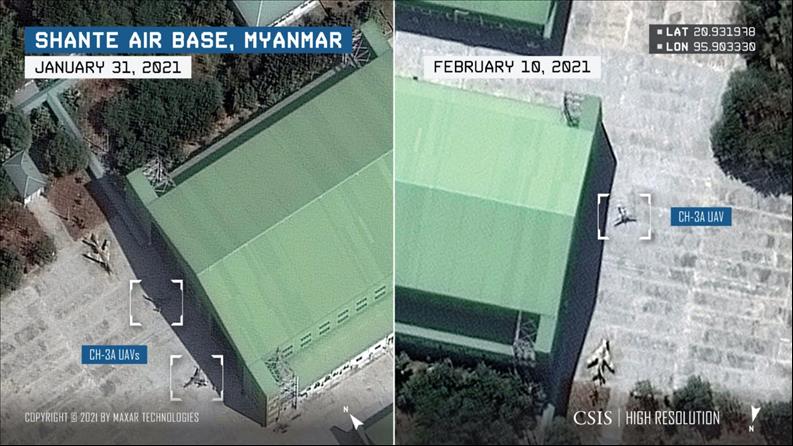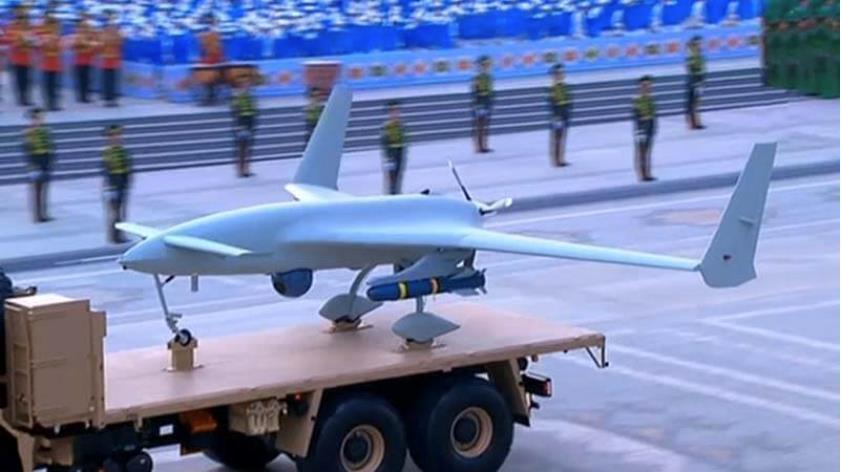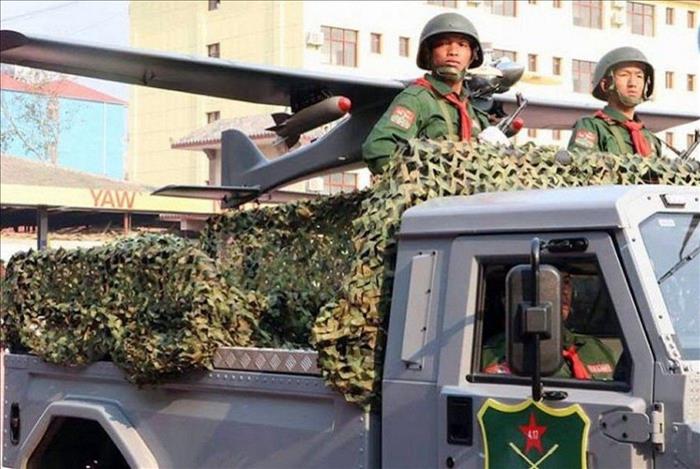(MENAFN- Asia Times) When Myanmar's military junta seeks to gain a tactical advantage against pro-democracy demonstrators or ethnic resistance groups, it sometimes deploys Chinese-made drones to survey the situation and provide crackdown targets.
The drones have recently been seen flying over protests in the central city of Mandalay, where scores of Civil Disobedience Movement (CDM) protesters have been killed by army snipers who observers suggest have likely used drone-provided intelligence, surveillance and reconnaissance (ISR) in their precision assaults.
They have also recently been sighted in ethnic areas including Kachin and Kayin states, where the regime has launched aerial bombardments in civilian areas that are driving new waves of refugees towards the border in an emerging humanitarian crisis.
Revelations that Myanmar's junta regime is using Chinese-made drones to support its suppression of protesters, with over 750 now dead, will undoubtedly give more fuel to CDM complaints that Beijing tacitly supports the February 1 coup, which suspended democracy and sparked a still escalating nationwide uprising.
The UK-based Janes International Defense Review and the Washington-based Center for Strategic and International Studies (CSIS) think tank have both recently identified these Unmanned Aerial Vehicles, or UAVs, as the Chinese-made CH-3A.
A May 6 CSIS report confirmed with satellite imagery the presence of CH-3A drones at Myanmar's Shante Air Base at Meiktila, south of the central city of Mandalay and home to the Myanmar Air Force's Central Operations Center and home to several squadrons.
The military acknowledged on April 29 that five rockets were fired by an unknown source were launched into the airbase, though no casualties or damage to military equipment were reported. It was not clear if the unknown assailants were deliberately the Chinese-provided drones.

Myanmar's Shante Air Base with Chinese drones indicated in brackets. Images: CSIS/Maxar Technologies
CH-3A drones are equipped with satellite data links, can carry up to 180 kilograms including rockets and have a range of around 960 kilometers or six hours of unmanned flight. They are capable of fielding AR-1 laser-guided air-to-surface missiles and YC-200 guided bombs.
CH-3As are built by China Aerospace Long-March International, a division of the state-owned China Aerospace Science and Technology Corporation (CASC).
The revelation that the military regime is using Chinese drones to finetune its repression and attacks comes as UN special rapporteur on the human rights situation in Myanmar Tom Andrews calls for an immediate arms embargo on Myanmar amid a rising bloodbath of protesters since the coup.
China has so far blocked via its veto power any Western proposal to censure or impose an arms embargo against Myanmar via the UN Security Council. CDM supporters, who have protested en masse in front of the Chinese embassy in Yangon, persistently point to Chinese state news agency Xinhua's characterization of the military takeover as a ''major cabinet reshuffle'' rather than a coup.
In apparent response, unknown assailants have attacked and torched several Chinese-owned factories in Yangon. On May 5, three junta security guards were stabbed to death while guarding a stretch of a China-built gas pipeline in Tawma village near Kyaukse University in the Mandalay Region.
To be sure, China's arms sales to the Tatmadaw are not new. China delivered as many as a dozen CH-3As to Shante Air Base between 2014-15, according to data compiled by the Stockholm International Peace Institute (SIPRI), an independent monitoring group. The procurements were then meant to be used in operations against ethnic rebels in Myanmar's border areas.
The CH-3As have been spotted in Kachin state's far north, according to news reports. Colonel Win Zaw Oo of the Myanmar Army's – or Tatmadaw's – western command told the now-banned website Myanmar Now in January that the military was using drones for surveillance in fights against the Arakan Army in western Rakhine state, but would not confirm or deny their use in combat.
''Of course, we use them if we need to. It's warfare and we fight to win,'' the colonel said at the time.
Like many other Chinese drones, the CH-3A was originally developed by the state-run China Academy of Aerospace Aerodynamics, or 701st Research Institute, an entity under the CASC.

The CH-3A on display during a military parade in China. Image: Facebook
The same kind of combat drones has been sold by China to Algeria while the improved CH-4 is deployed by the air forces of several countries, among them Pakistan, Indonesia, Egypt, Nigeria and Ethiopia – though none of those recipient countries have used the drones to monitor demonstrations or other popular movements.
When Myanmar's military started to gradually open the country to the West in 2010-11, the top brass decision was made in part to lessen its heavy dependence on China both for military wares and economic support, which top generals reportedly saw as a rising threat to national sovereignty.
That dependence is clear. The Myanmar Air Force relies on Chinese-built systems for nearly all its combat aircraft, along with a fleet of Russian MiG-29 multirole fighters and attack helicopters that have also been used recently on civilian areas of ethnic states.
Myanmar's military currently operates Chinese Nanchang Q-5 ground attack aircraft, which are primarily used in close air support roles, Chengdu J-7 fighters, Shenyang J-6 fighters and Chinese Y-8 medium-lift transport aircraft.
While the CH-3A's are the most advanced of Myanmar's drones, the air force and at least 22 Yellow Cat A2s, which are domestic versions of the Chinese UAV.
According to SIPRI, 56% of Myanmar's arms imports between 2010 and 2019 came from China, 31.6% from Russia and 12% were categorized as ''others'', which includes countries such as Ukraine, North Korea and Israel. The total value of arms purchases from 2010 to 2019 amounted to more than US$2.5 billion, the same research shows.
SIPRI's data covers major conventional weapons such as aircraft, armored vehicles, artillery, radar systems, missiles, and ships designed for military use. Excluded are transfers of other military equipment such as small arms and light weapons, trucks, small artillery, ammunition, support equipment, technology transfers and other services.
At the same time, sophisticated arms including drones and Man-portable air-defense systems (MANPADS) — or portable surface-to-air missiles —have ended up in the hands of the rebel United Wa State Army, widely seen as a Chinese proxy in the country's ethnic wars.

UWSA soldiers parade what is believed to be a Chinese-made armed drone, Panghsang, 2018. Photo: Twitter/Network Media Group
The UWSA is known to have supplied other ethnic groups that are currently fighting the Tatmadaw. It's not clear now if those flows have ceased, but the UWSA has not taken a clear position on the coup, which some have read as tacit support.
Nor is clear if China has provided new supplies to the Tatmadaw since the coup. Myanmar's arms imports peaked at $667 million in 2011, coincident with the Tatmadaw's overtures to improve relations with the West, a shift that resulted in more press freedom, the release of hundreds of political prisoners and allowances for political parties including the National League for Democracy (NLD) to contest elections, which it won in 2015 and 2020.
What Myanmar experienced in those early years of quasi-democracy was not, as many Western observers and think tanks hopefully characterized as a ''democratization process'', but rather the introduction of a new form of military rule with generals still in positions of power including through military appointees representing 25% of the seats in parliament and control over key ministries, namely defense, home and border affairs.
Attempts by NLD and other elected pro-democracy members in parliament to amend the 2008 constitution, which legally cements the military's ultimate power over the state, consistently failed due to the military's built-in veto power over charter changes.
But the coup was carried out nonetheless in response to the NLD's landslide win over a military-aligned party at the November 2020 election, which the top brass led by Senior General Min Aung Hlaing apparently saw as an existential threat to the military-dominated political status quo.
Ostracized by the West and US, the Tatmadaw is now once again turning to China for support in a time of isolation and need. Three and a half months after the putsch, however, it is still far from certain that the generals will be able to consolidate their coup before the nation becomes a fully-fledged failed state.
That's the last thing China wants on its southern border, particularly as tensions rise with the US and West in various other theaters. But as the Tatmadaw increasingly deploys its China-made drones, arms and wares to suppress the population, Beijing is being dragged into a conflict that is ultimately inimical to its regional interests.
MENAFN09052021000159011032ID1102053028